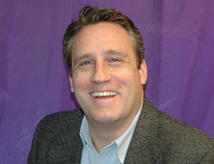Persuasion by the numbers
Format alters results of surveys, even as facts remain same
Would you rather support research for a disease that affects 30,000 Americans a year or one that affects just .01 percent of the population?
 The numbers represent about the same number of people, but how you answered explains how you understand numerical information, according to Gary Brase, pictured at left.
The numbers represent about the same number of people, but how you answered explains how you understand numerical information, according to Gary Brase, pictured at left.
"People are comfortable with simple frequencies and percentages," said Brase, an associate professor of psychology. "Everybody can understand five, six, 10, 20 or even 100, and percentages like 30 percent or 40 percent.
"But it's really large numbers that we don't have nailed down exactly. If you say there were 20,000 people at a concert versus 30,000 people, we don't have a good sense of how much bigger that is exactly."
Brase has studied the perceptions and applications of various numerical formats. He spoke on the topic at the Midwestern Psychological Association conference May 1-3 in Chicago. The research has appeared in several publications including the Journal of Behavioral Decision Making, the Journal of Nonprofit and Public Sector Marketing and the Journal of Extension.
Brase's interest began with theories about how the mind processes numbers. Brase said this research suggested that people prefer working with frequencies.
"But then we thought, let's just start asking them what they prefer," Brase said
To find out, Brase conducted two studies. One asked people to evaluate statistical information about forestry issues. The research showed that people find percentages and simple frequencies, such as one-third or two-out-of-five, easiest to understand. But the people studied also perceived absolute frequencies -- like 30 million Americans -- to bebigger than a fraction or ratio, even when the numbers were equivalent.
Another study analyzed the responses to postcards that presented the same information about cancer mortality rates in different formats. People responded most often to information presented in absolute frequencies. That is, framing mortality rates in millions of Americans rather than a ratio like 1 out of 100.
"When you want to persuade, you're interested in whole numbers and using a large reference class like the U.S. or world population," Brase said. "Take the numbers of people who have a rare disease. The percentage could be a tiny amount. But it also could be an impressive number if you consider a large population."
The opposite, Brase said, is doing something like saying that a person has a .0001 percent chance of getting that disease.
"People really are not understanding the numbers," Brase said. "All they get out of that information is that it's a really, really tiny amount."
For people to really understand an issue, Brase said perhaps the best approach is to present numerical information in as many ways as possible.